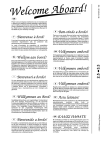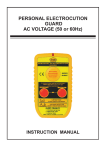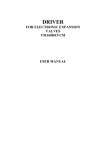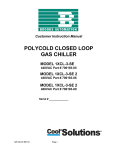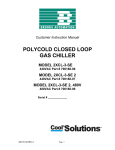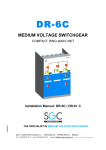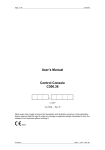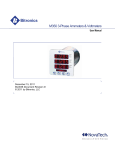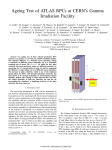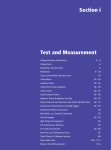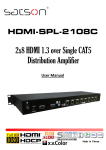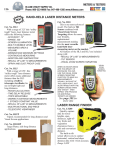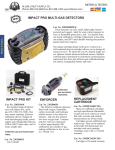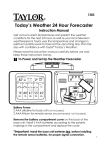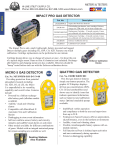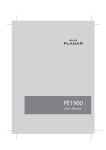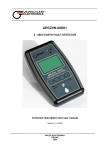Download HIGH VOLTAGE PHASE COMPARATORS
Transcript
USER'S MANUAL for HIGH VOLTAGE PHASE COMPARATORS PC Series Double Poles Model TPC7k TPC11k TPC22k TPC33k TPC44k System Voltage 6.6kV 11kV 22kV 33kV 44kV Full Scale 8kV 12kV 24kV 36kV 48kV INDEX PAGE SAFETY RULES............................................. 1 GENERAL DESCRIPTION............................. 2 PRINCIPLE OF OPERATION......................... 2 PROVING THE PHASE COMPARATORS..... 3 LIMIT MARK................................................... 3 LABELS AND MARKING................................ 4 RANGE OF MODELS..................................... 5 INSTRUCTION FOR USE.............................. 6 OPERATION................................................... 7 SPECIFICATIONS.......................................... 8 SCALES.......................................................... 9 DIRECTIONS FOR USE................................. 10 TESTING FOR PHASING PRESENCE.......... 11 CARE AND MAINTENANCE.......................... 12 LIMITED WARRANTY..................................... 13 NOTES............................................................ 14 SAFETY RULES • Only Personnel who are fully trained in the use of High Voltage Phase Comparators should use this equipment. • Be aware that the system that it will be used on are powered from high voltages which are lethal. • Before use, ensure that the Phase Comparators and any accessories are clean, free from cracks or deep scores, and are properly secured together. • Only the proper rated Phase Comparators must be used. Ensure that the Phase Comparator is properly rated for the voltage of the system under test. • Test the operation of the Phase Comparator before and after each test. • Do not allow any part of the Phase Comparator except the contact electrodes to come in contact with energized or earthed items. • Safe Working distance must always be observed. • Safety insulated Gloves and protective clothing and glasses must be wear when using the Phase comparator. • The Phase Comparator must only be handled by one person only. • Do not insert the Phase Comparator beyond its limit mark into the apparatus under test. The Limit mark is the red band. • The Phase Comparator should not be used as a synchronising Device or a voltage detector. • The Interconnecting lead/cord must not be allowed to come within 100mm (10cm) of the hand guard and must not be touched while testing. • Before using the Phase Comparator in the testing of factory assembled swtichgear, the manufacturer of the switchgear must be consulted as the suitability of the Phase Comparator in such testing. • Always check for Phase Presence before testing between Phases. Ensure that voltage is present on both phases before testing between phases. • The Phase Comparators are not to be subjected to a constant voltage for a period longer than 1 minute in every five minutes. -1- GENERAL DESCRIPTION • The range of high Voltage Phase Comparators have been designed to comply and exceeds the requirements of VDE0681Part5. • The Phase Comparators are double poles devices which are used to determine the correct Phase Relationship between two energized conductors of the Same nominal Voltage and Frequency. • Models are available to cover systems voltages from 1kV to 44kV 50/60Hz. • For other systems voltage, please contact the factory. • All models may be used indoor and outdoors in dry weather only. PRINCIPLE OF OPERATION • The PC range of Phase Comparators is a resistive devise which comprise mainly of resistors, a neon and a panel meter. The Phase Comparator draw current from the circuit or source under test. • The Phase Comparator consist of two inter-connected poles (the master pole with the panel meter and the slave pole). • The Master pole carries the panel meter with the color coded scale and the integral neon light indicator. • The color coded scale indicates "in-phase/out-of-phase" band on the scale. (Green = in-phase; Red=out-of-phase). • The Neon light lit up when the voltage between the poles is greater than ±1.2kV ±1.5kV. • If two energized conductors are out-of-phase and a contact electrode is touched onto each pole, current will flow between the conductors through the resistors (resistors are inside the fiberglass front end in each pole) in the poles and the interconnecting lead/cord. This will cause the neon to lit and the panel meter's indicator to move into the out-of-phase area (Red). • If two energized conductors are in-phase and a contact electrode is touched onto each pole, current will not flow between the conductors through the resistors in the poles and the interconnecting lead/cord. This should not cause the neon to lit and the panel meter's indicator to move. The indicator will stay into the in-phase area (Green). • Ensure that voltage is present on both phases before testing between phases. -2- PROVING THE PHASE COMPARATORS • Before and after using a Phase Comparator and accessories, a functional test should be performed on the Phase Comparator as It is to be used on the source or circuit to test. • A High Voltage Insulation tester can be used for this purpose. • When using a High Voltage Insulation tester, the Phase Comparator will indicate the voltage generated by that H.V. Insulation tester. • Please note that H.V. Insulation testers are generating DC voltage and have polarity. • The PC range of Phase Comparators are using a ½ bridge rectifier and current only pass one way into the panel meter. However, the neon must lit both ways. • When proving with a DC source as with a H.V. Insulation tester, the poles must be tested for both polarity to confirm that the panel meter only show voltage in one way, but confirm that the neon indicates both polarity. • The reading on the High Voltage Insulation tester also indicate the total value of the resistor chain and is also a good indication that the circuit is still correct and in good condition (See specifications). • A Proving Unit can also be used if a High Voltage Insulation Meter is not available. The Proving unit does not indicate how many mega ohms are in the front end or if the circuit is still in good condition or not. The Proving unit only output a DC voltage of 5kVdc. LIMIT MARK • • • • Each Phase Comparator has two poles. Each pole has a front end which is in Fiberglass tubing. Each pole has an Handle section. At the junction between the handle section and the front end section, there is a RED BAND which is the limit mark. • By definition, this mark, or the Red Band, indicates the physical limit to which the poles of the Phase Comparators may be inserted between live components or may touch them. -3- LABELS AND MARKING • The following labels must be present on the Master Pole. TPC 7k 6.6kV TPC 22k 22kV TPC 11k 11kV 50/60Hz TPC TPC33k 33k 33kV 50/60Hz 50/60Hz 50/60Hz 50/60Hz TPC 44k 44kV 50/60Hz PHASE PHASE PHASE PHASE PHASE PHASE COMPARATOR COMPARATOR COMPARATOR COMPARATOR COMPARATOR COMPARATOR 7kV 11kV 22kV 33kV 44kV Climatic Class - Normal Outdoor Climatic Class - Normal Outdoor Climatic Class - Normal Outdoor Climatic Climatic Class Class -- Normal Normal Outdoor Outdoor Climatic Class - Normal Outdoor CONFORMS TO DIN VDE 0681/5 • The following labels must be present on BOTH Poles. NOT FOR USE IN RAIN CAN BE USED AS A VOLTAGE TESTER 6.6kV 11kV 22kV 33kV 44kV DANGER: USE ON SYSTEMS UP TO 6.6kV ONLY AS PER INSTRUCTION MANUAL DANGER: USE ON SYSTEMS UP TO 11kV ONLY AS PER INSTRUCTION MANUAL DANGER: USE ON SYSTEMS UP TO 22kV ONLY AS PER INSTRUCTION MANUAL DANGER: USE ON SYSTEMS UP TO 33kV ONLY AS PER INSTRUCTION MANUAL DANGER: USE ON SYSTEMS UP TO 44kV ONLY AS PER INSTRUCTION MANUAL The Phase Comparator is designed to be used up to this voltage system only. Part Number Voltage System for this Phase Comparator TPC 11k 11kV 50/60Hz The Phase Comparator will operate over the frequency range 50 to 60 Hz. PHASE COMPARATOR 11kV Climatic Class - Normal Outdoor The Phase Comparator is designed for use on High Voltage Systems. • Care must be taken to observe the attached labels, which must not be removed. The labels warn of danger and to use only up to the rated voltage, as per instruction manual. The Labels "Frequency Range", "Year of Manufacture","not to be used in the rain", "not to be used as voltage tester" are self-explanatory and are to be strictly Observed. Read and Understand the Instruction manual before using the Phase Comparator. The Phase Comparator is suitable for use either indoor or outdoor in dry condition The user must keep hands The Phase Comparator will and all parts of the body perform correctly over behind the hand guard the temperaturerange to maintain safe of -25°C to + 55°C. WARNING working distances. STAY BEHIND HAND GUARD -4- RANGE OF MODELS • Models are available to cover system voltages from 1kV to 44kV @50 or 60Hz. • Contact the factory for information on models suitable for other voltages. • The following models are available as standard instruments: Model N° ===== System Voltage Voltage ============ Full Scale Voltage ======== Maximum Voltage ======== TPC7k 6.6kV 8kV 9kV ===== ============ ======== ======== TPC11k 11kV 12kV 15kV ===== ============ ======== ======== TPC22k 22kV 24kV 30kV ===== ============ ======== ======== TPC33k 33kV 36kV 40kV ===== ============ ======== ======== TPC44k 44kV 48kV 55kV ===== ============ ======== ======== -5- Display Type ====== Neon & Panel Meter ====== Neon & Panel Meter ====== Neon & Panel Meter ====== Neon & Panel Meter ====== Neon & Panel Meter ====== INSTRUCTION FOR USE • Before using the Phase Comparator, clean the Front End (FiberGlass) with a polymer polishing. • All models do not require batteries and are being signal driven (current taken from the source or circuit under test) and do not require arming. However, it is recommended that a functional test be carried out using an High Voltage Insulation tester or a proving unit. • To prove the Phase Comparator, set the voltage on the Proving unit or on the High Voltage Insulation tester, to suit the model of Phase Comparator. Turn the test "ON" or the proving unit "ON". The Neon should lit (if the voltage if high enough) and the indicator should move nearest the voltage measured. • Reverse the poles of the Phase Comparator and check that an out-of-phase indication is given. • They are no user serviceable parts on our range of Phase Comparators. Should the Phase Comparator become damaged, faulty or, suspect in any form, please consult with your nearest distributor to return it to the factory. • There must be galvanic contact between the test electrodes and the part of the installation under test and, no other part of the phase Comparator, except the electrodes, should be in contact with energized or earthed parts, in order to ensure accuracy of the display. -6- OPERATION To determine the correct phase relationship between two energized conductors, the following procedure should be followed: • First, Check that each Phase to be compared is individually energized. 1. With one handle held in each hand, touch one bare conductor (first phase which will be compared later) with one contact electrode and touch the earth with the other contact electrode. 2. The Neon will operate and the meter pointer will indicate the Red out-of-phase band indication which indicate that this phase is energized. The voltage scale will indicate the voltage phase -to-Earth or/and the percentage of the full scale. 3. Repeat the operation 1 and 2 with the other bare conductor (the other phase to be compared later) so that it is known that both Conductors are energized. • Now, you should know if both conductors are energized because you will have read the voltage Phase-to-Earth of both conductors. • If both phases are not energized, then, the remedial action will have to be carried out before proceeding to the next stage of the Test. • Compare the Phases. • If both Phases are energized (after checking between Phase and Earth that they are energized ) proceed to compare between the phases. • Now touch each bare conductor (each phase to compare) with a contact Electrode. • If the conductors (Phases) are in-phase, the neon will not lit and the meter pointer will not operate or the meter pointer will stay in the Green band. • If the conductors (Phases) are out-of-phase, the neon will lit and the meter pointer will operate or the meter pointer will go in the Red band. -7- SPECIFICATIONS Safety Standard IEC 61481 TPC7k Total Resistance Response time Neon Threshold Neon Lit Fully @ TPC11k TPC22k TPC33k TPC44k 4.48M ohm 6.78M ohm 10.82M ohm19.68M ohm26.8M ohm <1Sec 1.2kV 1.5kV <1Sec 1.2kV 1.5kV <1Sec 1.2kV 1.5kV <1Sec 1.2kV 1.5kV <1Sec 1.2kV 1.5kV TPC7k TPC11k TPC22k TPC33k TPC44k 775mm 400mm 775mm 400mm 775mm 500mm 775mm 665mm 775mm 820mm 1.175M 1.175M 1.275M 1.440M 2.1kG 2.1kG 2.2kG 2.4kG Composite Material with Polyurethane Fiber Glass Wound Tubing 1.595M 2.5kG Mechanical Lenght of Handle Lenght of Front End (Fiberglass) Total Lenght Total Weight Handle Material Front End Vibration Resistance: tested in accordance with IEC 68-2-6 Drop Resistance: tested in accordance with IEC 68-2-32 Bump: tested in accordance with IEC 68-2-2 Impact: tested in accordance with IEC 1010 Clause 8.2 Deflection: the contact electrodes must not deflect by more than 150mm when loaded at the electrode by 10N. Connection Lead.Cord Strenght: each pole connection to withstand 10000 swing with 10N Load applied and a vertical pull with 200N applied. Environmental Operating temperature:-25°C to +55°C Operating Humidity: 20 to 96% RH. -8- SCALES 0 0 % 50 % 50 5.3 TPC 22k 32 KV TPC 11k KV KV KV KV TPC 7k 24 24 100 16 % 50 16 12 100 12 % 50 8 8 100 8 0 0 AC % 50 4 0 0 AC 2.7 0 0 AC 0 AC AC 0 36 100 TPC 33k 48 100 TPC 44k Special Scales and configuration can be manufactured on a case by case basis. Contact the factory with your requirements. -9- DIRECTIONS FOR USE It is the user's responsibility to ensure that only competent personnel, with the necessary knowledge and training to work with high voltage, use and handle this equipment. Before using the Phase Comparators, it is recommended to check them with an High Voltage Insulation tester (if possible a variable one). For Phasing, it must be ensured that both feeders are in a live condition, of the same voltage and in a stable state, before commencing the phasing tests. The Phase Comparators comprises of two interconnected parts; these are the Master Stick, containing the indicator housing. The second stick is referred to as the slave. Contact Electrode Protective Cover Indicator Housing (Split Probe) Main (Master) Stick Front End (Master) Hand Grip Hand Guard Interconnecting Lead Front End (Slave) Slave Stick Split Probe Hand Grip Red Band (Limit Mark) (Contact electrode) Insulating element Resistif element REPRESENTATION FOR EXPLANATION PURPOSE M-S S-S Master Stick Slave Stick Interconnecting Lead -10- TESTING FOR PHASE PRESENCE Before doing the Phase Comparison test, you must ensure that the feeders to be compared are live. FEEDER "1" Phase "A" Phase "C" TESTING FOR PHASING No Indication - Neon OFF (does not lit) = IN PHASE FEEDER "1" Phase "A" M-S S-S FEEDER "2" Phase "A" Phase "B" Phase "B" Phase "C" Phase "C" Indication - Neon ON (does lit) = OUT OF PHASE FEEDER "1" Phase "A" M-S S-S FEEDER "2" Phase "C" Phase "B" Phase "B" Phase "C" Phase "A" Note that the links must be arranged so that the phases are Connected in Phase, as indicated by the dotted lines. Do Not Use Phasing Sticks unless you have been fully trained In High Voltage work and understand the system fully. -11- S-S S-S Earth To Check Phase Presence, measure the Voltage between Phase and Earth. The result will confirm that voltage is present and that the Earth amplitude are the same. M-S M-S Phase "B" FEEDER "2" Example: Preparing to Phase "A" Compare two Phases From different feeders Check that both phases to Phase "B" be compared are Live and have the Same amplitude. Phase "C" CARE AND MAINTENANCE • Storage: The Phase Comparator and it's accessories should be stored in the proprietary carrying case/bag when not in use. • Transporting: When the equipment is in transit it should be stored in its carrying case/bag. Whilst the equipment has been designed for field use it should not be subjected to excessive bumps and shocks. • Cleanliness: Dirt can cause surface tracking and it's therefore necessary to keep the Phase Comparator and its accessories clean by washing them in mild detergent solution. All part should be cleaned with the appropriate liquid. • Mechanical Damage: If surface scratches or dents can easily be seen by the naked eye, then the equipment should be returned to the factory of your nearest distributor for repairs since these blemishes act as traps for dirt and moisture. Mechanical damage would also necessitate the return of the equipment to the manufacturer. • Recelebration and Proof Testing: Every twelve months the Phase Comparator and it's accessories should be rechecked. This would include checking the threshold level of the neon, voltage proof testing in factory or accredited laboratory and pressure testing of the panel meter housing. Please note that there are no internal user replaceable parts. The Phase comparator must always be clean and dry before use and during use. Please store the Phase Comparator in a dry Place. -12- LIMITED WARRANTY We warrant the product manufactured by us to be free from defective material or factory workmanship and agree to repair or replace this product which, under normal use and service, disclose the defect to be the fault of our manufacturing, with no charge for parts and service. If we are unable to repair or replace this product, we will make a full refund of the purchase price. Consult the user's manual for proper instruction regarding use of this instrument. Our obligation under this warranty is limited to repairing, replacing or making refund of this test equipment which proves to be defective within forty eight months from the date of purchase. This warranty does not apply to any of our products which have been repaired or altered by unauthorized persons in any way so as, in our sole judgement, to injure their stability or reliability, or which have been subject to misuse, abuse, misapplication, negligence or accident or which have had the serial numbers altered, defaced or removed. All warranties implied by law are hereby limited to a period of fourty eight months, and the provisions of the warranty are expressly in lieu of any other warranties expressed or implied. The purchaser agrees to assume all liability for any damages or bodily injury which may result from the use or misuse of the product by the purchaser, or it's user, his employees, or others, and the remedies provided for in this warranty are expressly in lieu of any other liability we may have including incidental or consequential damages. We reserve the right to discontinue models at any time, or change specification, price or design, without notice and without incuring Any obligation. -13- NOTES We Exceeded the safety specifications wherever possible. However, we can't be held liable for misuse or bad manipulation. We simplified the Phase Comparators by not having any parts to assemble on site. There is no user serviceable parts or user assembled part in our Phase Comparators. Only the tip (contact electrode) has to be screwed on the Front end of each pole. They generally do not need to be removed by the user. For other kind of tips and contact electrodes, contact the factory or you nearest distributor. Getting regular training on your High Voltage equipment and on the electrical network / grid you are working on is a good practice and will help in keeping you safe. Always make a sketch before proceeding with testing High Voltage and ensure you are fully in control of the testing and understand Fully what is going on. Failure to do so can result in fatal accidents. -14-
















